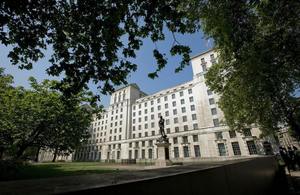HMS St Albans honours Arctic heroes 70 years on
In rugged surroundings, the Commanding Officer of HMS St Albans, Commander Tom Sharpe, and Britain’s Ambassador to Iceland, Ian Whitting, cast…

In rugged surroundings, the Commanding Officer of HMS St Albans, Commander Tom Sharpe, and Britain’s Ambassador to Iceland, Ian Whitting, cast a wreath into Hvalfjorður - a fjord which was once a vital staging area for the Arctic Convoys to the Soviet Union.
Seventy years ago this month, the lifeline delivering food, ammunition, trucks, tanks and other supplies to aid the Soviet war effort against the Third Reich entered a critical phase.
In May 1942, the 35 merchant ships of convoy PQ16 mustered in these same Icelandic waters. Despite a huge escorting force comprising British and American battleships, carriers, cruisers and destroyers, only 25 would safely reach their destinations of Murmansk and Arkhangelsk, having run a gauntlet of U-boats and Luftwaffe bombers off northern Norway.
Eight ships were sunk, two more were damaged.
In spite of such losses, PQ16 was hailed a success, but its successor, PQ17, suffered even heavier losses - only 11 of the 35 ships making for northern Russia got through.
Seven decades later and Portsmouth-based frigate HMS St Albans sailed from Reykjavik with international dignitaries, British Embassy staff and the Icelandic media, accompanied by the coast guard patrol vessel Thor, for a service of commemoration in Hvalfjorður, just ten miles (16km) north of the island’s capital.
On the flight deck of the Type 23 frigate the ship’s company mustered for a service of remembrance, before a wreath was dropped into the chilly waters in memory of all those who served on the most challenging of all convoy routes during the Second World War.
Between 1941 and 1945, more than 100 merchant and warships were lost carrying aid to the Soviet Union.
Grievous though these losses were, they accounted for just seven per cent of the shipping; nearly four million tons of supplies were safely delivered - accounting for a quarter of all the material supplied by western powers to the Soviet Union throughout the war.
As well as ceremonies in Hvalfjorður, St Albans took the rare chance to exercise with the Icelandic Coast Guard, practising ‘officer of the watch’ manoeuvres with Icelandic patrol vessel Thor. There was also a winching exercise with St Alban’s Merlin helicopter.
These days Royal Navy visits to Iceland are few and far between, so St Albans made the most of her rare opportunity to see the land of fire and ice - and allow locals to see a cutting-edge British warship.
The frigate opened her gangway to several hundred Icelanders who toured the upper deck of the ship and her Merlin helicopter to see first-hand what the ship is capable of and speak to members of the ship’s company.
St Albans also hosted an official reception and capability demonstration for more than 60 foreign dignitaries and British Embassy staff. Guests witnessed a number of briefings and demonstrations, included firefighting, first aid, search and rescue helicopter operations and bridge reactions.
Away from the ship, which was berthed just a mile-and-a-half (2km) from the heart of Reykjavik, a large number of her crew visited the hot springs at the Blue Lagoon and went on the Golden Circle tour, which included Thingvellir National Park, a 30-metre geyser, which erupted every ten minutes, and the Gullfoss Waterfall.